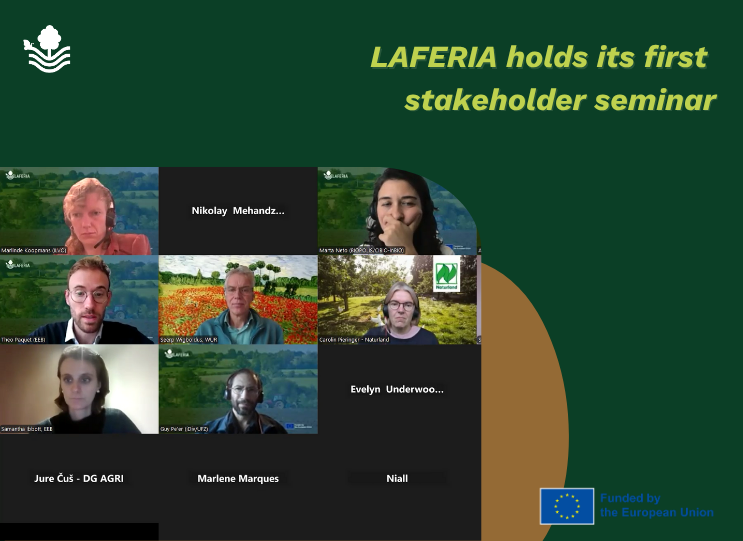On 14 October 2025, LAFERIA held its first webinar, welcoming stakeholders across different sectors. Moderated by Théo Paquet (EEB), the event lasted an hour and a half, concluding in an interactive session with breakout rooms. Paquet welcome participants by briefly introducing the project and the hopes and intentions behind LAFERIA’s stakeholder community.
Different key aspects of the project were presented during several sessions led by partners, beginning with a presentation by LAFERIA coordinator Francisco Moreira (BIOPOLIS), providing an overview of the project’s background, context, and objectives. He began by first defining landscape features (LF) and outlining their division into four different groups: woody, grassy, wet and stony landscape features. He continued by contextualising the necessity for the project, by highlighting how agricultural intensification has led to the loss of these landscape features, and emphasised the project’s concrete objectives and expected impacts.
After presenting the project’s seven case studies, stakeholder community and workplan, Moreira passed the baton to Marlinde Koopmans (ILVO) whose presentation centred on LAFERIA’s efforts in mapping existing initiatives for the reintroduction of LF. Koopmans outlined the different goals for the mapping, such as getting a detailed understanding of initiatives’ success and failures, and identifying possible pathways towards more diversified business models. She introduced the survey used to collect these, giving an overview of the type of initiatives that have been collected so far, and inviting participants to contribute.
Next up, Evelyn Underwood (IEEP) delved into the policy drivers that could incentivise the reintroduction of LF, as well as the main policy barriers in place. She presented the policy context, giving an overview of the EU Biodiversity Strategy 2030, Farm to Fork Strategy 2030, the EU Nature Restoration Regulation, the Common Agricultural Policy (CAP), the Water Framework Directive and Nitrates Directive, and the lack of EU-wide policy on soil preservation (which has, since then, changed thanks to the adoption of the Soil Monitoring and Resilience Directive!) and landscape features. Underwood gave a closer look at how these frameworks encompass landscape features.
The final session of the webinar, led by Guy Pe’er (UFZ/iDiv), focused on developing a shared vision for the reintroduction of LF. Highlighting the goal of reaching 10% LF in agricultural areas, he acknowledged the intricacies of this goal going throughout different parts of Europe. Overcoming challenges is a real part of the mission, and Pe’er emphasized the importance of going from local to national levels, recognising how different policies and directives are interconnected. The session closed with an overview of the different paths towards maximising impact, and key remaining questions.
Finally, Angela Lomba (BIOPOLIS) invited participants to participate in the breakout rooms, introducing the topics to be discussed during this session, namely Do you know of existing initiatives of landscape features’ reintroduction?, Under which conditions would landscape features’ reintroduction work? and What would be your vision for landscape features as part of viable rural areas?. Participants were divided into different rooms, encouraging knowledge exchange and the co-creation of solutions.
Watch the full webinar:
